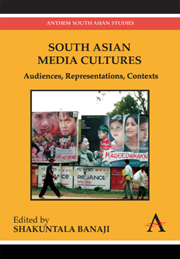Book contents
- Frontmatter
- Contents
- List of Illustrations
- 1 Introduction
- Part One Elaborating Audiences: Meaning, Use and Social Context
- 2 Talking Back to ‘Bollywood’: Hindi Commercial Cinema in North-East India
- 3 ‘Adverts Make Me Want to Break the Television’: Indian Children and their Audiovisual Media Environment in Three Contrasting Locations
- 4 Urdu for Image: Understanding Bangladeshi Cinema through its Theatres
- 5 Musical Media and Cosmopolitanisms in Nepal's Popular Music, 1950–2006
- Part Two Telling Texts: Media Discourse, Identity and Politics
- Part Three Alternative Producers: The Articulation of (New) Media, Politics and Civic Participation
- List of Contributors
5 - Musical Media and Cosmopolitanisms in Nepal's Popular Music, 1950–2006
from Part One - Elaborating Audiences: Meaning, Use and Social Context
Published online by Cambridge University Press: 05 March 2012
- Frontmatter
- Contents
- List of Illustrations
- 1 Introduction
- Part One Elaborating Audiences: Meaning, Use and Social Context
- 2 Talking Back to ‘Bollywood’: Hindi Commercial Cinema in North-East India
- 3 ‘Adverts Make Me Want to Break the Television’: Indian Children and their Audiovisual Media Environment in Three Contrasting Locations
- 4 Urdu for Image: Understanding Bangladeshi Cinema through its Theatres
- 5 Musical Media and Cosmopolitanisms in Nepal's Popular Music, 1950–2006
- Part Two Telling Texts: Media Discourse, Identity and Politics
- Part Three Alternative Producers: The Articulation of (New) Media, Politics and Civic Participation
- List of Contributors
Summary
In the literature on South Asian popular music, topics such as the Indian film industry, nationalism, and modernism tend to loom large. Writings often centre around binary oppositions, such as modernity edging out tradition, nationalism competing with regionalism, India's culture dominating over its neighbours, and Western culture replacing South Asian culture. While I agree with a number of the insights that follow from such binary models, I would suggest that these oppositions do not always draw out the full complexity and multiplicity of relations among local and translocal processes, traditions, identities and genres in Nepal. For even the most patently nationalistic Nepali music may contain within itself the seeds of a subsequent cultural movement that celebrates the West or India. Likewise, self-consciously Western-influenced expressions can become vehicles of Nepali national pride. To model the eclecticism and creativity that Nepali musicians and listeners exercise through their popular music calls for more subtle and sophisticated analytic tools.
In this chapter I combine ethnographic data with a social and musical history in an account of popular music in Nepal, 1950–2006, organised around a theme of cosmopolitanism. By invoking cosmopolitanism, I am not proposing that popular songs are treatises on the global community of human beings, or on cultural diversity. What I am proposing is that as Nepali popular songs draw together Nepali and non-Nepali musical elements and symbols, they inspire, among other things, various ways of thinking and feeling about and beyond the local.
- Type
- Chapter
- Information
- South Asian Media CulturesAudiences, Representations, Contexts, pp. 91 - 106Publisher: Anthem PressPrint publication year: 2010



